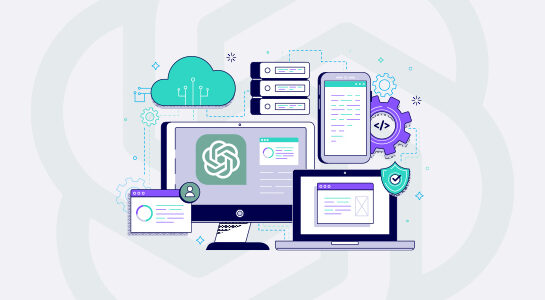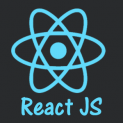Getting Started With ChatGPT & React
Nowadays, with hundreds of millions of websites and web applications on the internet, the competition is fierce. So everyone is looking for the best websites with the latest UI/UX design and functional features to stand out from the crowd. (In this blog, we’ll take a look at the UI/UX design aspects)
One way to go about creating the best website is by using the best front-end development platform for it, and ReactJS is one of, if not the best, options available on the internet. It is easy to learn, performance-focused, handy tools and resources, SEO-friendly, provides reusable components, and even offers cross-platform support. So you can create the best user interfaces, single-page applications (SPAs), websites, web applications, etc.
But you can make the UI/UX of your websites and web apps even better. Have you heard about ChatGPT? Launched in November 2022, ChatGPT is an AI chatbot and language model that can help you gather information with human-like conversations and has endless use cases in almost every domain.
ChatGPT is one of the biggest, most fascinating technological advancements ever. You can ask any question or present it with a query, and it will provide you with the relevant information within the right context, with a good level of accuracy. Now, although ChatGPT has its limitations, most of them were addressed with its more advanced iteration, GPT4, which has made it one of the best AI chatbots and language models out there.
So for this blog, we decided to discuss how you can integrate ChatGPT into your ReactJS website or web app with the best tips and practices.
What Is ChatGPT?
Developed by OpenAI, ChatGPT is a language model designed to understand and respond to natural language inputs using machine learning algorithms and a vast corpus of training data. It assists users by answering questions and providing information on various topics in a human-like text format.
This AI model analyzes a vast collection of text-based data, from books to blogs/articles and social media posts to online community forums. That allows it to recognize patterns in natural language and generate contextually relevant responses while being grammatically correct.
When a user enters a natural language text-based input, ChatGPT processes the input and analyzes it with ML algorithms. Based on the input text and the context of the conversation, I generate a response that is designed to be as human-like as possible while still being informative and accurate.
Why Integrate ChatGPT Into Your ReactJS Website or App?
ChatGPT has proven to be a revolutionary tech advancement in the short five months it’s been here. ChatGPT has provided some excellent use cases for nearly every industry, from serving nearly accurate information to having human-like conversations.
So integrating it with ReactJS can prove to be quite beneficial for your website or web app in several ways:
- Improved UI: ChatGPT can help provide your ReactJS website or web app with a more interactive, conversational UI to improve the overall user experience. It lets the users interact with your application using natural language, ensuring a more intuitive experience than traditional user interfaces.
- Increased engagement: If the users have a better time on your React website with a conversational interface, it will encourage them to spend more time on your application, improving user engagement
- Better customer support: One of the best aspects of ChatGPT that you can benefit from is its ability to present the answers in a conversational format, addressing the user. That can help you offer 24×7 support to your users, which will not only improve customer satisfaction, but it will also reduce support costs. So the users can get solutions to their queries and issues without waiting for the support agent to respond.
- Personalized recommendations: Another advantage of ChatGPT is its ability to analyze user data and provide tailor-made recommendations based on their search trends, preferences, and behavior. That helps improve the user experience and engagement.
- Improved data collection: ChatGPT can analyze the whole website or app and help you collect valuable data and info about user interactions, preferences, and behavior, which you can use to directly improve almost every aspect of your application and business enterprise.
- Competitive advantage: One of the obvious reasons to integrate ChatGPT (or any other AI model, for that matter) into your ReactJS website is that it helps gain a definitive edge over the competitors. It helps deliver a unique user experience, making your website or web app a favorable option in the industry.
.
To summarize, integrating ChatGPT into the ReactJS website will make its UI much better and will ensure the users get a little extra compared to your rival sites or apps. Consider it an X-factor on your site.
Best Practices For Integrating ChatGPT Into Your React App
ChatGPT, a thoroughbred AI model, and ReactJS, one of the Top JavaScript frameworks. Combine them, and you’ll have a website with advanced features, innovative UI, and a captivating user experience. But if you want the best results, you’ll need to follow the industry’s best practices.
So let’s discuss the best practices for integrating ChatGPT into your ReactJS website or app:
Use a pre-built chatbot template
A pre-built chatbot template can be an excellent way to integrate ChatGPT into the ReactJS website since it is a helpful resource for saving time and effort. A chatbot template is essentially a pre-built chatbot that can be customized to fit the specific needs of your application. These templates are typically designed with a specific framework in mind, such as React, and can be easily integrated into your application code.
Since it provides a pre-built foundation, you’ll be able to customize it to your preferred specifications quite effortlessly. Moreover, the developers design these templates with standard industry practices, like error handling and natural language processing, into consideration.
Use Serverless Functions
When integrating ChatGPT into your React app, serverless functions can help simplify the integration process. They are a type of cloud computing service for executing code without having to worry about the underlying infrastructure.
Serverless functions can be easily integrated into your application code, making the integration and code management process much more manageable. Moreover, serverless functions are highly scalable, which means you can easily adjust the amount of developers and computing resources dedicated to your ChatGPT code depending on the demand of your application. So your website will be equipped to handle more user requests without any performance issues.
Implement Error Handling
When integrating ChatGPT into a React app, it is important to implement effective error handling to ensure that the chatbot functions correctly and reliably.
One aspect of error handling involves anticipating and preventing errors before they occur. So if a user inputs a question that the chatbot is not programmed to answer, the error handling should direct the user to an appropriate response or provide helpful suggestions for alternative inquiries.
Then, there’s detecting the errors through debugging software and determining the cause of the error and how to resolve it. That will help quickly address the issues and improve the performance of the chatbot.
Lastly, error handling involves preventing errors from future recurrence by implementing rectifications or workarounds to take care of a few particular issues. It also involves addressing usability issues by incorporating user feedback and frequent testing.
Test Your Chatbot Thoroughly
Of course, after integrating ChatGPT to your ReactJS website or app, you will want to go for comprehensive testing to ensure it performs and delivers a positive user experience as well as you expected. There are a few key aspects of testing a chatbot like ChatGPT:
- Functional Testing: This aspect of the testing check’s how accurately ChatGPT or any other chatbot understands, interprets, and responds to user queries.
- Performance Testing: Performance testing checks the chatbot’s response time and sees how well it can handle multiple requests simultaneously, all the while monitoring its performance.
- Usability Testing: Usability testing checks ChatGPT’s user-friendliness by testing its user interface (on the app) and how well it guides the users through the conversation flow. Basically, it sees if the chatbot is able to provide clear and concise responses to the users.
- Integration Testing: It tests the ChatGPT chatbot’s ability to access data sources and external APIs, and how well it can work with other chatbots or virtual assistants.
- Security Testing: This testing strategy tests ChatGPT’s ability to maintain data security and prevent any unauthorized access. This test shows whether ChatGPT’s chatbot can handle sensitive user data and prevent hacking or other security breaches.
So by using a pre-built chatbot template, using serverless functions, implementing error handling, and testing the chatbot, you can expect an effective integration of ChatGPT with your React website or web app. Integrating ChatGPT with your ReactJS websites and web apps can be a little tricky sometimes. So you can hire ReactJS developers to ensure a correct integration so your users can have a good experience on your website.
Tips for Optimizing ChatGPT in Your React App
After you have integrated ChatGPT or any other AI chatbot with your ReactJS website or web app, you’ll need to implement some optimization practices to ensure the best performance:
Use the Correct API Endpoints
API endpoints are the URLs that help ensure effortless communication and timely responses between your website or web app and the ChatGPT servers. It’s important to use these API endpoints for a few crucial reasons.
First off, it ensures your website is communicating with the right servers, resulting in fast and accurate responses. Secondly, using the wrong API endpoints may result in errors and unexpected issues, so you may want to use the right one.
In the beginning, ChatGPT API provides comprehensive documentation, with a list of available endpoints and how to use them. So follow the process and make sure you are using the right endpoints for the best experience with ChatGPT.
Leverage the Power of Webhooks
Webhooks let you receive real-time updates and notifications from ChatGPT. Leveraging them can help improve real-time capabilities and responsiveness.
Configure the setting in your ChatGPT API to send notifications to a URL endpoint (like a serverless function or web service) already in use in your website or app. So when ChatGPT sends a notification, your website or app will be able to take prompt action based on the notification info.
That helps ensure a more engaging and personalized experience for your users.
Customize ChatGPT’s Responses
If you are looking to improve ChatGPT’s effectiveness and user engagement, customizing its responses can be a great tactic. Customizations based on the specific use cases and target audience can help create a more personalized and effective experience for your users, improving engagement.
Here are some tips for ChatGPT customization:
- Understand your audience: Before starting the customization process, understand your target audience and their preferences. For example, what questions are they likely to ask? And, what is their preferred language? So you can create a more relevant and helpful experience.
- Create a style guide: You can create a style guide to ensure that the responses provided by ChatGPT have a consistent tone and messaging, especially if multiple people are working on the responses.
- Use dynamic responses: Dynamic responses are more human-like and engaging. For e.g., using variables for the user’s name in a response or personalizing the response based on previous interactions can be excellent.
- Incorporate visual elements: Visual aspects like images, GIFs, or emojis can help make the experience more engaging and fun. But make sure there aren’t too many of these visuals, and they’re relevant to the conversation.
Finally, make sure you test multiple iterations of these customized responses to see if they’re accurate, relevant, and engaging. Also, make sure to pay heed to the user feedback and analytics to see how users and customers find ChatGPT on your React website. Moreover, act on the feedback to improve the user experience as it will translate into higher engagement.
Conclusion
ReactJS is an excellent platform for creating engaging websites and web apps. But nowadays, people are constantly looking for something new and revolutionary, and what better way to go than ChatGPT?
In a short 5-6 months, this AI language model has taken the world by storm. In fact, ChatGPT reached 100 million active users in January, just two months after its launch. Everyone is fascinated by its quick, relevant, and engaging responses, along with a human-like conversation flow.
So integrating it with your ReactJS website or app would be really beneficial for the overall user experience. The best practices to integrate ChatGPT with your React website are using a pre-built chatbot template, using serverless functions, implementing error handling, and
testing your chatbot thoroughly.
But what after you have integrated ChatGPT? How can you optimize it for the best results? So we’ve also listed a few of the best tips for ChatGPT optimization that can help you churn out a higher engagement. You can use the correct API endpoints, leverage Webhooks, and customize the responses of your chatbot to ensure people have the most relevant and engaging answers to their queries.
But it’s understandable to be a little intimidated by the integration process and the best practices. So it might be a better idea to get in touch with a ReactJS development company. They can help integrate and optimize ChatGPT in your website or app much more effectively.
Hope your React website reaches new heights with the power of ChatGPT.
FAQs
Q.) How to test my ChatGPT integration comprehensively?
There are several automated testing tools available on the internet to help you test your ChatGPT integration. They simulate the user inputs and check for errors or issues with every aspect of your website linked with ChatGPT. You can also conduct manual tests by having beta users interact and provide you with accurate feedback on its performance and accuracy.
Q.) Can I use ChatGPT for other types of applications besides chatbots?
Yes, ChatGPT is an excellent AI language model with the capability of processing tasks like language translation, text summarization, and content generation for websites or social media.
Q.) How can I ensure my chatbot is accessible to users with disabilities?
There are several ways to ensure your chatbot is accessible to users with disabilities. You can use accessible design practices like using semantic HTML, providing alternative text for images, and ensuring that you can use keyboard controls to navigate through ChatGPT.
Q.) How to improve the accuracy of my ChatGPT model?
To improve the accuracy of your ChatGPT model, fine-tune it on a larger, more high-quality dataset relevant to your use case. Moreover, there are some hyperparameters and training techniques that you can experiment with to optimize the model’s performance and accuracy.


















